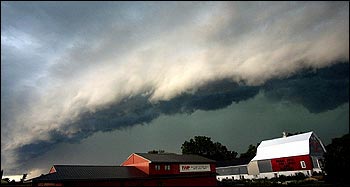- Air Homepage
- Weather Maps
- Forecast Hourly Weather
What prompts meteorologists to forecast hourly weather?
When do we forecast hourly weather? It's not uncommon for meteorologists to make sudden changes to their predictions when weather patterns change.
Find more about meteorology here
Meteorologists need hourly forecasts: The Science of Surprise - Have you ever wondered why the weather can change so dramatically between hourly observations? Discover the secret physics of atmospheric deformation, the stretching and reshaping of air masses that create sharp weather boundaries and force forecasters to make emergency updates every hour.
Why do weather changes and variations happen so suddenly? Conditions can change dramatically between hourly observations due to sudden changes. This makes forecasting hourly weather fun. A radar display with animated systems can be fun to watch.
Here's why you might want to check hourly weather forecasts. They're handy when you're planning outdoor activities or traveling. Check out the hourly forecast if you're planning a picnic, so you don't get caught in the rain. When you're planning a long car trip, hourly forecasts can help you avoid storms.
It's easy to know about short-term weather changes with hourly weather forecasts. It makes planning outdoor activities or deciding when to do certain tasks that require specific weather conditions a bit easier. You can also watch for severe weather warnings.
By doing so, you will be able to relate the observed conditions to your expectations.
The following atmospheric mechanism may make it necessary to forecast weather hourly (or less):
Deformation
The size or mass of the air parcel doesn't change in the formula below. Just the shape. An elastic object deforms when it changes shape without changing its size or color.
Engineers use words like malleable, which means it can be squashed, and ductile, which means it can be stretched. The same thing happens to soft metals, doughy substances, and masses of fluids like air and clouds. They are all types of deformation.
In meteorology, deformation means stretching and reshaping air blobs. It's reversible, so we can call it elastic deformation. Math and physics formulas for this type of shape-change go like this:
Deformation = du/dx – dv/dy
We want d to mean partial derivative in deformation. Velocity is represented by the letters u and v. Deformation is how each direction's velocity component changes as you move along the same direction.
How does that work? If you face east, is the wind at your back? As you move forward, does it blow harder at your back? Turn and face north, then ask the same questions.
Our maps and recorders would then show tightly packed gradients of temperature or humidity. We can get surprised by sudden changes in the air caused by these vectors. Possibly requiring us to forecast hourly weather.
Of all the science jobs, weather we forecasters are responsible for amending our projections frequently and even predicting the weather hourly.
Would you like to be considered for one of those positions? They're becoming available at any time.
Where is deformation found?
Deformation is shown on weather maps. In a vorticity field, or streamline field if you prefer, one would be found near a saddle point or col. It's like this.
Do you know what a col is? This is the low point between two mountains going one way. The col would be the high point between two valleys on your left and right. Take a look at a two-dimensional map. There would be a col between two areas marked high and two areas marked low.
Here is a simple example. Perhaps the highs would lie directly north and south of our middle point. Meanwhile, lows show up east and west. The col is in the middle.
Weather patterns can be affected by atmospheric deformation
There are a lot of factors that can cause this deformation, including the rotation of the Earth, air masses moving, and topography.
 Deformation and storms
Deformation and stormsDeformation of the atmosphere creates high- and low-pressure systems. The air pressure changes as air masses move across the Earth's surface. A high-pressure system is created when air is compressed and becomes denser. In contrast, when air expands, it becomes less dense and rises, creating a low-pressure system.
Another way atmospheric deformation affects weather is by creating atmospheric waves. Different factors, like temperature and pressure, can cause these waves, which can change weather patterns over large areas. El Niño Southern Oscillation (ENSO) is an atmospheric wave pattern that affects ocean temperatures, which affects weather patterns around the world.
Overall, atmospheric deformation affects weather patterns in a big way. Predicting and preparing for severe weather events requires an understanding of how atmospheric deformation affects the weather.
How does deformation lead us to forecast hourly weather?
It's two types of deformation zones that make us adjust our weather forecasts.
1) Longitudinal – stretched along the wind, and
2) Transverse – across the wind and
advected (transported) by the wind.
Northern Hemisphere analysts look for these on the north side of cyclones. There are areas of high vorticity and low pressure.
Meteorologists use this principle to forecast hourly weather because it shows us where the cloud edge is. These cloud formations can be compared with satellite pics, and our understanding of meteorological processes.
Go back from Forecast Hourly Weather to the
Forecast Map Weather web page.
#12
Search this site for more information now.
How do we forecast hourly weather when things change rapidly?
Is it necessary for analysts to forecast hourly weather? We may be surprised at any time by astonishing changes in the air.
Do you have concerns about air pollution in your area??
Perhaps modelling air pollution will provide the answers to your question.
That is what I do on a full-time basis. Find out if it is necessary for your project.
Have your Say...
on the StuffintheAir facebook page
Other topics listed in these guides:
The Stuff-in-the-Air Site Map
And,
Thank you to my research and writing assistants, ChatGPT and WordTune, as well as Wombo and others for the images.
OpenAI's large-scale language generation model (and others provided by Google and Meta), helped generate this text. As soon as draft language is generated, the author reviews, edits, and revises it to their own liking and is responsible for the content.






New! Comments
Do you like what you see here? Please let us know in the box below.